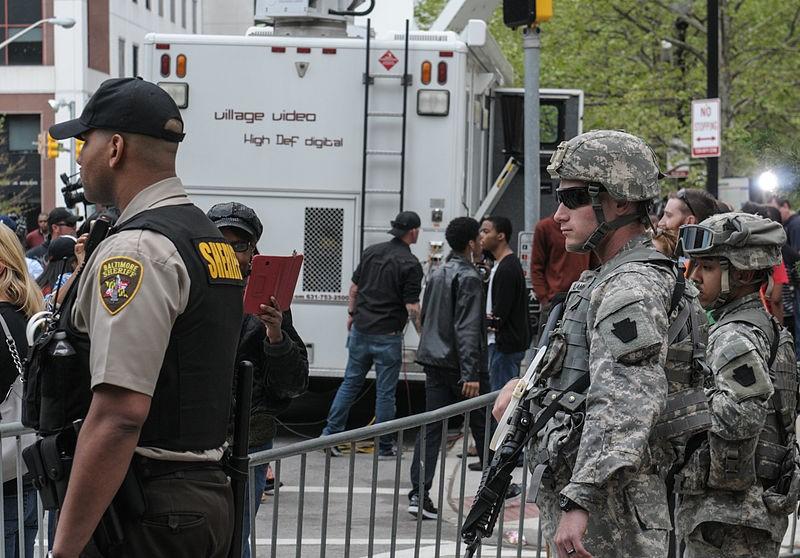Revisiting Spike Lee’s “Do the Right Thing” amid race problems in America
June 4, 2015
On April 19, a 25-year-old African-American man named Freddie Gray died as a result of sustained neck and spine injuries from transport by six police. On the 27th of that month, he was to be buried at New Shiloh Baptist Church. It would, for the residents of Baltimore, be a relatively cool day. No advisories for inclement weather were put into effect; some may have believed the day would go on peacefully, and would simply be one in which friends and family paid respects to Gray. This, any belief in stability, was inaccurate. For the past two days, a myriad of flyers and social media accounts had called for a “purge” of rioting near Mondawmin Mall. Two days earlier, protests against Gray’s death had become violent in some areas, resulting in 34 arrests. Later on the 27th, the purge called for was carried out; over a hundred arrests were made; a heavily anticipated Baltimore Orioles game was postponed; a police car was set afire; two CVS pharmacies were looted and arsoned; Governor of Maryland Larry Hogan declared a state of emergency; and a 10 o’clock curfew was mandated. The next day, the Baltimore Orioles played their game against the Chicago White Sox in a cheerless, empty ballpark. This had never been done in the 112-year history of Major League Baseball, and I doubt many mental pictures would better represent the disorientation and absurdity of it all.
Writers and analysts, when faced with events of great hysteria, often turn to the arts for things to brand prophetic. Here, there is little use in such things, but we cannot deny that many films hold much relevance. One example is “Do the Right Thing” (1989); we still talk about the Spike Lee classic not only for its themes of race tensions but also its political ambiguity and cinematic technique.
The film has been described as a comedy-drama, or as a drama with certain comic elements. Its events take place on a Brooklyn street, on the hottest day of the year. As the film progresses, tension builds between the characters, and gradually the bigotry in everyone comes to the forefront. Amid this downhill slope, the filmmakers never push an agenda. Any film of this nature could have, but the crew chose to set aside all dogmas. The film references the work of civil rights activists and emphasizes the differences in their teachings, while never advocating one approach over the other. No answers or solutions are advocated. All the film’s events are presented in a straightforward manner, leaving the viewer to think for himself or herself about any “solutions.” For this reason it avoids being partial or “preachy.”
In a famous sequence, taking place in the afternoon, several characters shout racist insults and stereotypes. Quickly, the camera zooms into each different character’s profile, the effect being that all insults are thrown straight into the viewer’s face, adding discomfort. Later on, when rioting breaks out in the evening, there is a slow-motion shot in which the camera zooms into Mookie’s (played by Lee himself) face. His expression is that of someone speechless with all of the cacophony and violence around him – and this shot is accompanied by somber clarinet. Slow motion in visual media is either a hit or miss; here it is easily a hit, calling attention to Mookie’s disillusionment. Surely this disillusionment existed in many more as well.
We can make connections between “Do the Right Thing” and the past few months’ headlines surrounding race-related police brutality. Last December, a grand jury decided not to indict Daniel Pantaleo in the death of Eric Garner; in April, officer Michael Slager shot Walter Scott multiple times and ultimately killed him. Demonstrations for these deaths were generally peaceful. This contrasts with the April 27th protests regarding Freddie Gray’s death. What links “Do the Right Thing” with the narrative of current events is the film’s focus on escalation rather than aftermath. When the riots in the film break out, it is clear police brutality is an immediate cause, but the underlying causes are given far more time because they deserve time. On April 27th in Baltimore, there was, likewise, a source of tension regardless of the protests: it was gradual rather than immediate, and self-evident rather than explicitly stated. Our recurring debates over the efficacy of rioting mirror its ending, in which the quotes by Martin Luther King, Jr. and Malcolm X are juxtaposed against one another.
The film is both a classic and just as much of a discussion point now as it ever has been.


